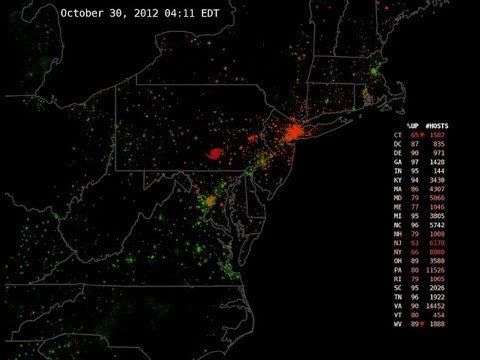Tracking Internet Outages in Sandy’s Wake
A new network-monitoring system shows the hurricane’s path by animating downed Internet connections

For the past year, graduate students Aaron Schulman and Ramakrishna Padmanabhan and professor Neil Spring of the University of Maryland’s department of computer science have been looking at the effects of bad weather on residential Internet connectivity, using a system they refer to as Thunderping. Their scheme uses the network utility Ping to try to connect with computers before, during, and after severe weather events. From the connections that drop out during episodes of severe weather such as Hurricane Sandy and last year’s Hurricane Irene, they can judge where Internet connectivity is lost. Schulman joins IEEE Spectrum to walk through an animation that shows minute-by-minute results from Hurricane Sandy.
Transcript:
Aaron Schulman: Every time a host goes down, it’s shown up as a little blip on our map. And you can see these little blips start going all over the New Jersey and New York area.
David Schneider: Welcome to the Full Spectrum. I’m David Schneider. Today we’re going to be talking by phone with Aaron Schulman, a graduate student in computer science at the University of Maryland. He’s been working with fellow graduate student Ramakrishna Padmanabhan and his advisor Neil Spring on an Internet monitoring project where they look at the residential Internet outages during incidents of bad weather. They were ready when Sandy struck, and they produced a remarkable animation showing the results.
David Schneider: Thanks for joining us, Aaron. Can you tell us a little bit about the project?
Aaron Schulman: The goal of this project is to observe how residential Internet connections are affected by regular, everyday weather events, like rain and snow and snowstorms, and also by these more severe events, like Hurricane Sandy and, last year, Hurricane Irene.
Aaron Schulman: We started the work actually about a year ago. We monitor the alert feed from the National Weather Service. And basically, for all the counties in the United States whenever there’s a weather event coming up, they’ll issue an alert. When an alert comes up for an area, we find residential Internet IP addresses in that area. Then we send Ping messages to these IP addresses. And basically, it’s a simple message that we send from our server, and then the residential Internet connection will reply to that message.
David Schneider: So you should have a good picture of the Internet going out, neighborhood by neighborhood.
Aaron Schulman: So at the beginning here, we see that most of the connections we’re pinging, most of the IP addresses we’re pinging, are up. And we’re pinging 70 000 IP addresses here as the storm is approaching all around the east coast. And as it continues, we start to see there was an early failure somewhere in the Washington, D.C.–Maryland area. We can see that Maryland’s percentage of hosts that are up drops down to 90 percent. That’s sort of an interesting thing.
Now as the storm is sort of coming on shore, we see that these little—every time a host goes down, they show up as a little blip on our map. And you can see these little blips start going all over New Jersey and New York area. But what’s interesting is we also see them all over the state of Pennsylvania, Connecticut, and even there’s a few correlated blips that look like they show up in Massachusetts. So we can see the widespread outage as it occurs here.
Now when the hurricane disappears from the map, we now see sort of the recovery. And these are some hosts that are now going to again—after the storm’s passed—start responding to our pings that we’re sending them.
David Schneider: Well, those were some remarkable results. Thank you for joining us today on the Full Spectrum, Aaron. I’m David Schneider.
NOTE: Transcripts are created for the convenience of our readers and listeners and may not perfectly match their associated interviews and narratives. The authoritative record of IEEE Spectrum’s video programming is the video.
Video: David Schneider, Celia Gorman
Animation and slides: Aaron Schulman, Ramakrishna Padmanabhan, Neil Spring
David Schneider is a senior editor at IEEE Spectrum. His beat focuses on computing, and he contributes frequently to Spectrum's Hands On column. He holds a bachelor's degree in geology from Yale, a master's in engineering from UC Berkeley, and a doctorate in geology from Columbia.